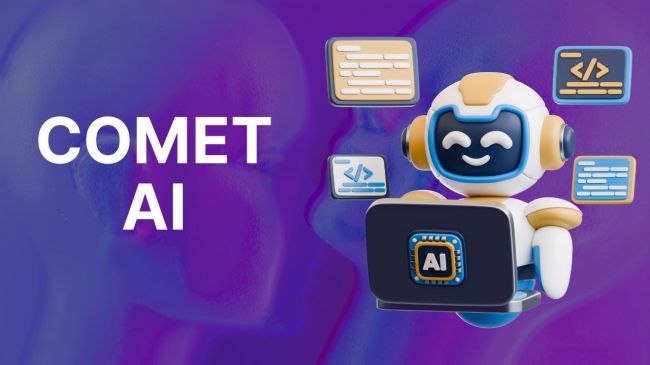On This Page
- What to Look for in an AI Email Marketing Tool
- Best AI Email Marketing Tools — Overview, Pros & Cons, Pricing
- 1. ActiveCampaign
- 2. Brevo (formerly SendinBlue)
- 3. Mailchimp
- 4. HubSpot (with “Breeze Copilot” etc.)
- 5. Seventh Sense
- 6. Mailmodo
- 7. Rasa.io
- Trade-Offs & What You Sacrifice / Gain
- “Best For” Recommendations (use-cases)
- Pros & Cons Recap
- What I’d Do If I Were You (Strategy)
- Conclusion
AI is reshaping email marketing—from writing subject lines to optimizing send times, segmenting audiences, and automating follow-ups. The right tool can save hours and significantly improve engagement. But “AI” is broad: different tools lean more heavily on copy generation, predictive behavior, automation workflows, or CRM integration. My aim here is to help you understand what’s out there, which tool matches which kind of user, and what trade-offs are involved.
What to Look for in an AI Email Marketing Tool
Before diving into specific tools, here are key dimensions to consider:
| Feature | Why It Matters |
|---|---|
| Content generation / Copywriting | Helps with subject lines, body text, tone; speeds up creation. |
| Predictive send time / Delivery optimization | Helps improve open & click rates by sending when a recipient is likely to act. |
| Segmentation & personalization | Better relevance = better engagement. |
| Workflow automation | Triggered emails, drip campaigns etc. |
| Integrations | CRM, e-commerce, analytics tools for better data & funnel continuity. |
| Pricing & scalability | As your contact list and number of campaigns grow, costs and usage limits become important. |
| Ease of use | Steep learning curves, complex UI can reduce ROI if usability is poor. |
Best AI Email Marketing Tools — Overview, Pros & Cons, Pricing
Here are some of the top AI-enabled email marketing tools in 2025, what they’re best for, where they shine or fall short, and how much they cost.
1. ActiveCampaign

Best for: Mid-sized businesses that want strong automation + personalization + multi-channel campaigns.
Key Features:
- Predictive sending (optimal send times) to raise open rates.
- Smart content/copy suggestions.
- Extensive workflow automations & audience segmentation.
- Integrations with many apps and e-commerce platforms
Pros:
- Very powerful automation capabilities.
- Good predictive features (send times, etc.).
- Strong in converting data into actionable insights.
Cons:
- It can get expensive as you scale.
- Some interfaces are complex; onboarding takes effort.
- For small campaigns / low-volume users, many features may go unused (i.e., you may pay for what you don’t need immediately).
Pricing:
Starts from ≈ US$15/month for basic features.
Going up to more expensive tiers (Plus, Pro, Enterprise) as you add more contacts, you get more features.
2. Brevo (formerly SendinBlue)
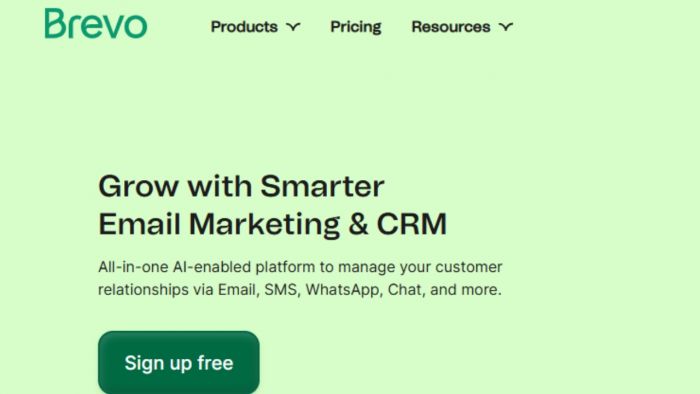
Best for: Small to medium businesses needing an affordable, simpler tool with smart AI features.
Key Features:
- AI-assisted copy generation.
- Predictive send times, auto-segmentation, dynamic recommendations.
- Email + transactional emails + simple built-in CRM.
Pros:
- Good value, especially at lower volumes.
- Easier to adopt for teams without much prior email automation experience.
- Free / lower-cost entry.
Cons:
- Predictive/advanced features are less deep than some specialized tools.
- Some limits around how complex automations can become.
- Analytics may be less granular in lower tiers.
Pricing:
Free plan includes some AI email builder features.
Business plan starts from ≈ US$18/month for 5,000 emails.
3. Mailchimp
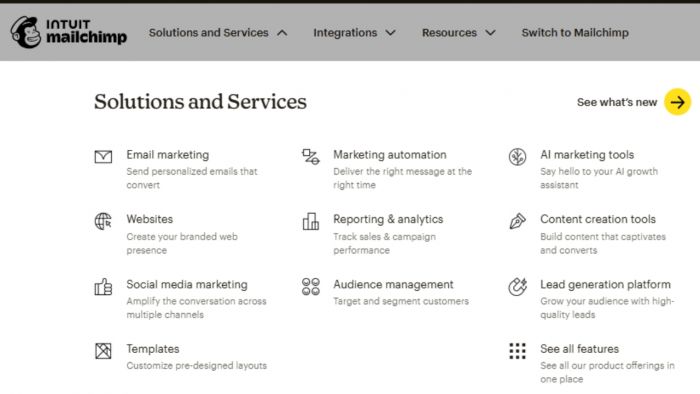
Best for: Small businesses / beginners; those wanting a well-known, all-round tool with brand recognition, decent AI features.
Key Features:
- Intuit Assist: generative AI for drafting email content, summary, and tone adjustments.
- Content optimizer (for readability, branding).
- Send time optimization (though often more “average best time” than individual-level optimization).
Pros:
- Very easy to use with many templates.
- Strong brand, lots of integrations.
- Good starter plans / free trials.
Cons:
- AI features are often not as advanced in terms of individual behavioural prediction.
- As you grow, costs can escalate.
- Some features are locked behind higher tiers.
Pricing:
Need at least the Standard plan to access many AI features; starts at about US$20/month for ~500 contacts.
4. HubSpot (with “Breeze Copilot” etc.)

Best for: Businesses that already use or plan to use full CRM + Sales + Marketing automation, needing a unified platform.
Key Features:
- AI-aided content (headings, paragraphs, tone) via tools like Breeze.
- Qualitative improvements (refining text, summarization, etc.).
- CRM integration, workflows, tracking of leads, etc.
Pros:
- Very strong platform if you're using multiple channels (sales, marketing, etc.).
- Powerful data integrations & insights.
- AI features are present even in earlier tiers in some form.
Cons:
- Higher cost, especially for larger teams or many contacts.
- Onboarding & setup are more involved.
- Sometimes overkill if you just want “simple email campaigns.”
Pricing:
Starter or lower plans have fewer seats/features; Professional tiers are more expensive.
For example, the Sales Hub Professional plan is ~US$100/month per seat for certain features (excluding onboarding) in some configurations.
5. Seventh Sense
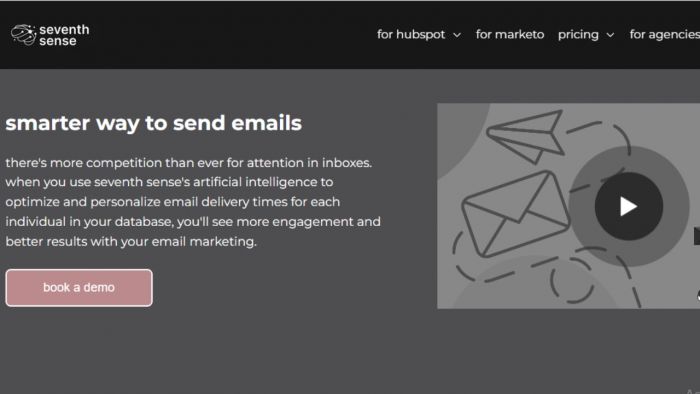
Best for: Teams or users who want to optimize when to send emails to maximize open/clicks; delivery & timing optimization.
Key Features:
- Learns from recipient behavior across time to pick the best send times.
- Integrates with marketing tools to adjust sending frequency/timing.
Pros:
- Can meaningfully improve open rates by optimizing timing.
- Useful especially when sending to large, diverse lists across time zones.
Cons:
- It doesn’t always do full content creation or advanced workflow automation; it’s more of an “add-on” or specialist in timing.
- Setup & calibration can take time / good historical data.
Pricing:
For example, their HubSpot “Business” plan starts at US$80/month.
Other plans (Enterprise, etc.) are custom quotes.
6. Mailmodo

Best for: Marketers and eCommerce businesses that want interactive and AMP-style emails, and more engaging content.
Key Features:
- Interactive email features (AMP, forms, etc.).
- AI to help with content + email design, automations.
Pros:
- Helps make emails more engaging (which improves click / interaction rates).
- Good for creative / eCommerce-oriented brands wanting something beyond static email.
Cons:
- Higher initial cost for interactive features.
- Some recipients or email clients may have limited support for AMP / interactive content (compatibility issues).
- More complex to design & test.
Pricing:
Pricing starts at ≈ US$49/month (billed annually) for certain plans.
7. Rasa.io
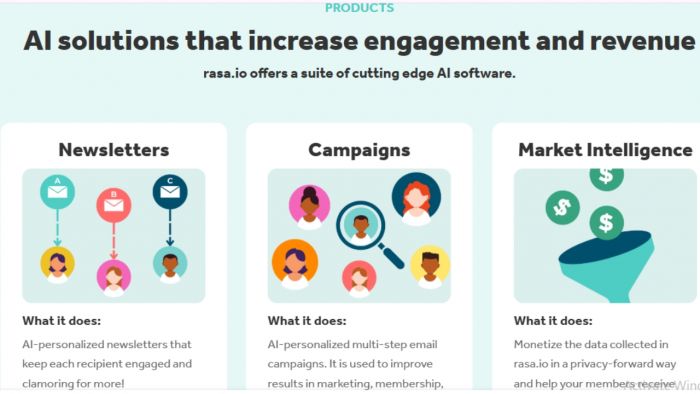
Best for: Organizations (newsletters, content publishers, nonprofits, etc.) that want to curate personalized content for each subscriber.
Key Features:
- Automatically curates content based on subscriber interests/behaviors.
- Sends more personalized content without manual content selection for each user.
Pros:
- Saves a lot of manual effort for content-heavy newsletters.
- Improves engagement because the content is more relevant to the subscriber.
Cons:
- Higher starting cost; might be more than basic tools.
- Less control over exact content sent (curation might miss some editorial nuance).
- Requires a healthy content ecosystem to feed into it (if you don’t have much content, the benefits drop).
Pricing:
One note: some plans start around US$190/month+ for more advanced features.
Trade-Offs & What You Sacrifice / Gain
- Breadth vs Depth: Tools like ActiveCampaign or HubSpot cover a lot of ground, but the depth in any single area (e.g., interactive emails or advanced send-time learning) might be less than that of specialist tools.
- Cost vs Usability: The more features, the steeper the learning curve. For small teams, a simpler UI with fewer but well-executed features may be better.
- AI “assist” vs full automation: Some tools just assist with copy, send time, etc. Others try to fully automate workflows. More automation can save time, but it also means less manual control.
- Data & integration dependency: AI works well only if you have quality data. Poor segmentation, bad contact hygiene, and weak analytics lead to poor results even with AI.
“Best For” Recommendations (use-cases)
Here are some sample recommendations depending on your business profile/needs.
| Profile | Best Picks |
|---|---|
| Small business / solo marketer wanting simple campaigns + content help | Mailchimp, Brevo |
| E-commerce store that wants interactive campaigns and product recommendations | Mailmodo, ActiveCampaign |
| Newsletters / publishers who want curation + personalization | Rasa.io |
| Businesses already using a CRM + looking to unify marketing & sales | HubSpot, ActiveCampaign |
| Want to squeeze all possible open-rates via timing and deliverability | Seventh Sense |
| Working with tight budget + small list | Start with free / low-cost plans of Brevo or Mailchimp, then scale |
Pros & Cons Recap
Pros:
- Saves time: content generation, scheduling, and automation reduce repetitive manual work.
- Increased engagement: better personalization, send time optimization, and better subject lines.
- Better use of data: predictive analytics, segmentation.
- Scaling capability: once set up, you can run more campaigns with less incremental effort.
Cons:
- Cost creep: as contacts, features, and sending volume grow, cost rises.
- Potential for generic / templated content if AI is over-relied on or not tuned well.
- Dependency on quality data: if your data (segmentation, behavioural history) is weak, AI may not help much.
- Learning curve/setup time: specialized features may need many settings, integrations, and some “clean-up” of email lists, etc.
What I’d Do If I Were You (Strategy)
If I were setting up email marketing now, here’s a path I’d follow:
- Start small. Pick a tool with a free or low-cost plan that gives basic AI content generation + send time optimization.
- Clean up email list, define segments & buyer personas. The better your data, the more useful the AI becomes.
- Test features. Try subject line suggestions, A/B test send times, etc. Monitor which features move metrics (open rate, CTR, etc.).
- As the list/scope grows, consider investing in more advanced tools or upgrading tiers: interactive emails, better automation workflows, behavior-based triggers, etc.
- Always measure, iterate. AI helps, but isn’t magic — human oversight, testing, and tweaking matter.
Conclusion
There’s no one “best” AI email tool for everyone. The right tool depends on your goals (engagement vs scaling vs automation), how much you already spend, and how much complexity you can manage. But among the tools out there in 2025, there are excellent options for almost every profile—from solo creators and startups, to larger brands.
Post Comment
Be the first to post comment!
